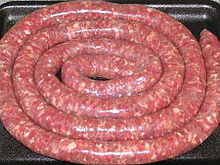Boerewors

Raw boerewors
|
|
| Place of origin | South Africa, Zimbabwe |
|---|---|
| Main ingredients | Minced meat |
| |
|
Boerewors ([ˈbuːrəvors]) is a type of sausage which originated in South Africa, is an important part of South African cuisine and is popular across Southern Africa. The name is derived from the Afrikaans words boer ("farmer") and wors ("sausage"). Boerewors must contain at least 90 percent meat, and always contain beef, as well as lamb, pork, or a mixture of lamb and pork. The other 10% is made up of spices and other ingredients. Not more than 30% of the meat content may be fat. Boerewors may not contain any "mechanically recovered" meat (meat derived through a process where meat and bone are mechanically separated).
Boerewors is thought to derive from a form of sausage made south of the Ardour River in France. It is made from coarsely minced beef (sometimes combined with minced pork, lamb, or both) and spices (usually toasted coriander seed, black pepper, nutmeg, cloves and allspice). Like many other forms of sausage, boerewors contains a high proportion of fat, and is preserved with salt and vinegar, and packed in sausage casings. Traditional boerewors is usually formed into a continuous spiral. It is often served with pap (traditional South African porridge / polenta made from mielie-meal). Boerewors is also very common throughout Namibia, Botswana, Mozambique and Zimbabwe as well as with expatriate South and Southern African communities in Australia, New Zealand, Canada, Ireland, the Netherlands, Taiwan, the United Kingdom, and the United States.
...
Wikipedia
